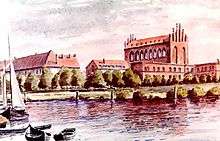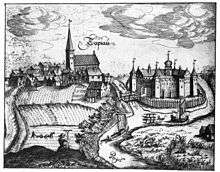Gvardeysk
| Gvardeysk (English) Гвардейск (Russian) | |
|---|---|
| - Town[1] - | |
 Central square in Gvardeysk | |
.svg.png) Location of Kaliningrad Oblast in Russia | |
 Gvardeysk | |
|
| |
.png) | |
|
| |
| Administrative status (as of December 2013) | |
| Country | Russia |
| Federal subject | Kaliningrad Oblast[1] |
| Administrative district | Gvardeysky District[1] |
| Town of district significance | Gvardeysk[1] |
| Administrative center of | Gvardeysky District,[1] town of district significance of Gvardeysk[1] |
| Municipal status (as of May 2014) | |
| Urban okrug | Gvardeysky Urban Okrug[2] |
| Administrative center of | Gvardeysky Urban Okrug[2] |
| Statistics | |
| Population (2010 Census) | 13,899 inhabitants[3] |
| Time zone | USZ1 (UTC+02:00)[4] |
| First documented | 1254[5] |
| Town status since | 1722 |
| Previous names |
Tapiow,[5] Tapiau (until 1946)[6] |
| Postal code(s)[7] | 238210 |
|
| |
| Gvardeysk on Wikimedia Commons | |
Gvardeysk (Russian: Гвардейск; IPA: [ɡvɐrˈdʲejsk]), known prior to 1946 by its German name ![]() Tapiau (Lithuanian: Tepliava/Tepliuva; Polish: Tapiawa/Tapiewo), is a town and the administrative center of Gvardeysky District in Kaliningrad Oblast, Russia, located on the right bank of the Pregolya River 38 kilometers (24 mi) east of Kaliningrad, the administrative center of the oblast. Population: 13,899 (2010 Census);[3] 14,572 (2002 Census);[8] 11,904 (1989 Census).[9]
Tapiau (Lithuanian: Tepliava/Tepliuva; Polish: Tapiawa/Tapiewo), is a town and the administrative center of Gvardeysky District in Kaliningrad Oblast, Russia, located on the right bank of the Pregolya River 38 kilometers (24 mi) east of Kaliningrad, the administrative center of the oblast. Population: 13,899 (2010 Census);[3] 14,572 (2002 Census);[8] 11,904 (1989 Census).[9]
History

Peter of Dusburg wrote of a settlement known as Tapiow, first documented in 1254, and the neighboring fort Surgurbi built by 1265.[5] The Old Prussian names were derived from the words tape, teplu, toplu, tapi, meaning "warm", and sur garbis, meaning "around the mountain". During the 13th century Prussian Crusade, the area was conquered by the Teutonic Knights. To protect Samland from the Nadruvians and Scalvians, the crusaders built a wooden fort between the Deime and Pregel Rivers in 1283–1290. This was replaced by Tapiau Castle, a stone Ordensburg, in 1351.
The settlement gradually became known by the German crusaders as Tapiau. Vytautas, the later Grand Duke of Lithuania, was baptized in Tapiau in 1385. After the transfer of the Grand Master's seat from Marienburg to Königsberg, Tapiau became the site of the Order's archives and library from 1469 to 1722.

Tapiau became a part of the Duchy of Prussia in 1525. The Tapiau Castle was often used as a second residence of the Prussian dukes; Albert of Prussia died there in 1568. It became a part of the Kingdom of Prussia in 1701, receiving town privileges from King Frederick William I of Prussia in 1722. It was a part of the Prussian Province of East Prussia and was administered in Landkreis Wehlau (1818–1945). Tapiau became a part of the German Empire during the unification of Germany in 1871.
Unlike most other towns in northern East Prussia, Tapiau was largely undamaged during World War II. Following the war's end in 1945, it was annexed by the Soviet Union and renamed Gvardeysk ("guard town") in 1946.[6] Of the town's German population of more than 9,000, those who had not fled or been killed in the final months of the war were expelled and gradually replaced by Soviet settlers.
Administrative and municipal status
Within the framework of administrative divisions, Gvardeysk serves as the administrative center of Gvardeysky District.[1] As an administrative division, it is, together with one rural locality (the settlement of Prigorodnoye), incorporated within Gvardeysky District as the town of district significance of Gvardeysk.[10]
Within the framework of municipal divisions, since June 11, 2014, the territories of the town of district significance of Gvardeysk and of four rural okrugs of Gvardeysky District are incorporated as Gvardeysky Urban Okrug.[2] Before that, the town of district significance was incorporated within Gvardeysky Municipal District as Gvardeyskoye Urban Settlement.[2]
Coat of arms
The coat of arms of Gvardeysk depicts a bare hand holding a sword amongst clouds, beneath a golden sun. When the town was known as Tapiau before 1946, the golden sun also included the Tetragrammaton (Jehova-Sonne).[11]
Sights
Sights of Gvardeysk include a church from 1502 and the ruined Tapiau Castle, reconstructed into an orphanage in 1879. It has been used as a prison since 1945.
People
Tapiau's most famous resident was the German Impressionist painter Lovis Corinth (1858–1925), who donated the painting Golgatha for the altar of the town's church in 1910; the painting disappeared near the end of World War II. The house where Corinth was born still stands in Gvardeysk. Other notable people associated with the town include Albert, Duke of Prussia (1490–1568), who died in Tapiau.
References
Notes
- 1 2 3 4 5 6 7 Law #463
- 1 2 3 4 Law #319
- 1 2 Russian Federal State Statistics Service (2011). "Всероссийская перепись населения 2010 года. Том 1" [2010 All-Russian Population Census, vol. 1]. Всероссийская перепись населения 2010 года (2010 All-Russia Population Census) (in Russian). Federal State Statistics Service. Retrieved June 29, 2012.
- ↑ Правительство Российской Федерации. Федеральный закон №107-ФЗ от 3 июня 2011 г. «Об исчислении времени», в ред. Федерального закона №271-ФЗ от 03 июля 2016 г. «О внесении изменений в Федеральный закон "Об исчислении времени"». Вступил в силу по истечении шестидесяти дней после дня официального опубликования (6 августа 2011 г.). Опубликован: "Российская газета", №120, 6 июня 2011 г. (Government of the Russian Federation. Federal Law #107-FZ of June 31, 2011 On Calculating Time, as amended by the Federal Law #271-FZ of July 03, 2016 On Amending Federal Law "On Calculating Time". Effective as of after sixty days following the day of the official publication.).
- 1 2 3 Oesterley, p. 676
- 1 2 Энциклопедия Города России. Moscow: Большая Российская Энциклопедия. 2003. p. 105. ISBN 5-7107-7399-9.
- ↑ Почта России. Информационно-вычислительный центр ОАСУ РПО. (Russian Post). Поиск объектов почтовой связи (Postal Objects Search) (Russian)
- ↑ Russian Federal State Statistics Service (May 21, 2004). "Численность населения России, субъектов Российской Федерации в составе федеральных округов, районов, городских поселений, сельских населённых пунктов – районных центров и сельских населённых пунктов с населением 3 тысячи и более человек" [Population of Russia, Its Federal Districts, Federal Subjects, Districts, Urban Localities, Rural Localities—Administrative Centers, and Rural Localities with Population of Over 3,000] (XLS). Всероссийская перепись населения 2002 года [All-Russia Population Census of 2002] (in Russian). Retrieved August 9, 2014.
- ↑ Demoscope Weekly (1989). "Всесоюзная перепись населения 1989 г. Численность наличного населения союзных и автономных республик, автономных областей и округов, краёв, областей, районов, городских поселений и сёл-райцентров" [All Union Population Census of 1989: Present Population of Union and Autonomous Republics, Autonomous Oblasts and Okrugs, Krais, Oblasts, Districts, Urban Settlements, and Villages Serving as District Administrative Centers]. Всесоюзная перепись населения 1989 года [All-Union Population Census of 1989] (in Russian). Институт демографии Национального исследовательского университета: Высшая школа экономики [Institute of Demography at the National Research University: Higher School of Economics]. Retrieved August 9, 2014.
- ↑ Resolution #640
- ↑ Hupp, p. 36
Sources
- Калининградская областная Дума. Закон №463 от 27 мая 2010 г. «Об административно-территориальном устройстве Калининградской области», в ред. Закона №281 от 6 декабря 2013 г. «О порядке рассмотрения Калининградской областной Думой предложений о присвоении наименований географическим объектам или их переименовании, информирования населения и выявления его мнения о присвоении наименований географическим объектам или их переименовании на территории Калининградской области». Вступил в силу со дня официального опубликования. Опубликован: "Калининградская правда" (вкладыш "Ведомости Правительства Калининградской области"), №112, 26 июня 2010 г. (Kaliningrad Oblast Duma. Law #463 of May 27, 2010 On the Administrative-Territorial Structure of Kaliningrad Oblast, as amended by the Law #281 of December 6, 2013 On the Process Used by the Kaliningrad Oblast Duma to Consider the Proposals to Assign Names to Geographic Objects or to Rename Them, to Inform the Populace and Gather Their Opinion on Assigning Names to Geographic Objects or Renaming Them on the Territory of Kaliningrad Oblast. Effective as of the day of the official publication.).
- Правительство Калининградской области. Постановление №640 от 30 августа 2011 г. «Об утверждении реестра объектов административно-территориального деления Калининградской области», в ред. Постановления №877 от 21 ноября 2011 г «О внесении изменения в Постановление Правительства Калининградской области от 30 августа 2011 г. №640». Вступил в силу со дня официального опубликования. Опубликован: "Калининградская правда" (вкладыш "Официально"), №170, 15 сентября 2011 г. (Government of Kaliningrad Oblast. Resolution #640 of August 30, 2011 On the Adoption of the Registry of the Objects of the Administrative-Territorial Divisions of Kaliningrad Oblast, as amended by the Resolution #877 of November 21, 2011 On Amending the Resolution of the Government of Kaliningrad Oblast #640 of August 30, 2011. Effective as of the day of the official publication.).
- Калининградская областная Дума. Закон №319 от 10 июня 2014 г. «Об объединении поселений, входящих в состав муниципального образования "Гвардейский район", и организации местного самоуправления на объединённой территории». Вступил в силу со дня официального опубликования. Опубликован: "Калининградская правда" (вкладыш "Официальный вестник Правительства Калининградской области"), №103, 11 июня 2014 г. (Kaliningrad Oblast Duma. Law #319 of June 10, 2014 On the Merger of the Settlements Within the Municipal Formation of "Gvardeysky District" and on the Organization of the Local Self-Government on the Merged Territories. Effective as of the day of the official publication.).
- Hupp, Otto (1896/1898). Königreich Preußen: Wappen der Städte. Flecken und Dörfer (in German). Frankfurt: Verlag von Heinrich Keller. p. 185. Check date values in:
|date=(help) - Oesterley, Hermann (1883). Historisch-geographisches Wörterbuch des deutschen Mittelalters (in German). Gotha: Justus Perthus. p. 805.